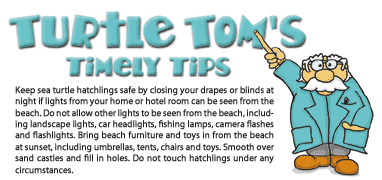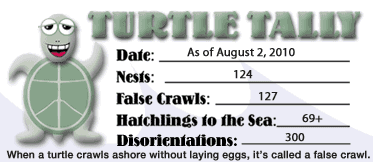Season's first turtles hatch
From the August 4, 2010 IssueHOLMES BEACH – Anna Maria Island’s first loggerhead sea turtle nest of 2010 hatched 69 turtles on July 27 at 27th Street, bringing to light a persistent problem.
Some lights can still be seen from the beach at night, a violation of the law in all three Island cities, according to Suzi Fox, of Anna Maria Island Turtle Watch and Shore Bird Monitoring.
“It’s much better than in past years in every city,” she said, adding that so far this year, lights have not contributed to any disorientations of either mother turtles laying nests or hatchlings making their way to the Gulf from the Island beaches.
But it’s already happened on Longboat Key. Ironically, about 40 turtle hatchlings died on Turtle Beach last week due to lighting violations, which can result in fines.
With sea turtles dying from the Deepwater Horizon oil spill and the unusually long, cold winter of 2010, it’s even more important to spread the word about lights until the 900 or so turtles still in nests on Anna Maria Island’s sands make it safely to the sea, turtle officials say.
Rental agents can be the first line of defense for turtles by making sure that they advise renters about the turtle laws, according to Holmes Beach Code Enforcement Officer Nancy Hall.
Compliance with lighting and beach furniture laws has improved over the past five years in the city, she said, adding that she tries to work with people until they comply, citing them if they do not.
Teach your tourists
Educating visitors is an ongoing challenge, agreed Anna Maria Code Enforcement Officer Gerry Rathvon.
In response to a complaint last week, Rathvon contacted visitors from the United Kingdom who were totally unaware of the turtle laws, which prohibit any lights that can be seen from the beach. She called Anna Maria Accommodations, the visitors’ rental agency, and offered to supply more turtle brochures to hand out to their renters.
Brochures that detail the laws are delivered by the cities and by Turtle Watch to rental agents at the beginning of turtle season; landlords without management companies can pick them up at the three city halls, the Chamber of Commerce, the library and online at www.islandturtles.com.
Sometimes, visitors get the brochures, but in their rush to get to the beach, they never read them, Rathvon said.
“Our ordinance says lights have to be shielded from the beach from sunset to sunrise, and no beach furniture of any kind can be left out,” she said.
Anna Maria Mayor Fran Barford walks the beach each morning and leaves nice notes on furniture, Rathvon said, but if it’s still there the next day, the city confiscates the furniture and the owner has to pay a fine to get it back. A beach chair may cost $5, an umbrella, $10, and a tent, from $25 to $50.
“We welcome the visitors, but we also have an ordinance and we have to protect the turtles,” she said.
Hang tags
In Bradenton Beach, Code Enforcement Officer Gail Garneau and another staffer put hang tags on the doorknobs of beachfront properties a few days before nearby nests are due to hatch to remind people about lighting laws. They try to hang the tags on Fridays before weekend visitors arrive, she said.
With the high turnover of renters, interior light violations are common, she said – blinds and drapes are often left open, inadvertently allowing light to hit the beach. Some violations are more blatant, with people taking lights out to their patios to play cards, or people using lanterns to fish at night in the surf.
City staff inspects the beaches at night, and often throws away small furniture left on the beach, she said, so it is not as easy to retrieve as it is in Anna Maria. The Bradenton Beach ordinance prohibits leaving furniture on the beach after sunset. A proposed change to the Holmes Beach lighting ordinance will allow that city to remove beach furniture left out for 48 hours.
One of the strangest violations Garneau has seen was a kite that was left flying overnight, attached to a sand castle. Both are dangerous to hatchlings, and anyone should feel free to level a sand castle at sunset or fill in a hole, she said.
Prior to nesting season, which began May 1, the city sent out about 100 letters with notices of lighting violations, which explain that violations of city, state and federal turtle laws can incur fines. Most complied, but last week, she had to send another 15 letters to those that did not comply.
“It never ends,” Fox said.



